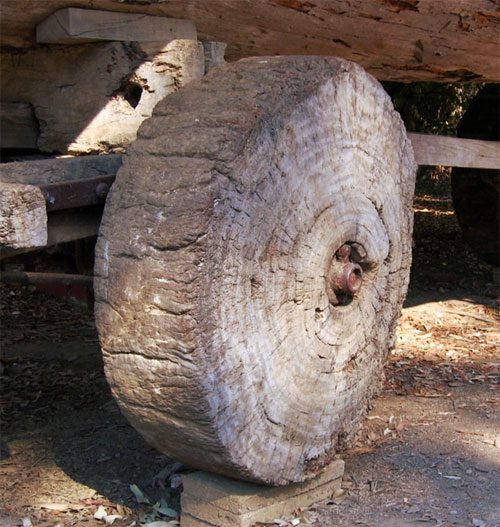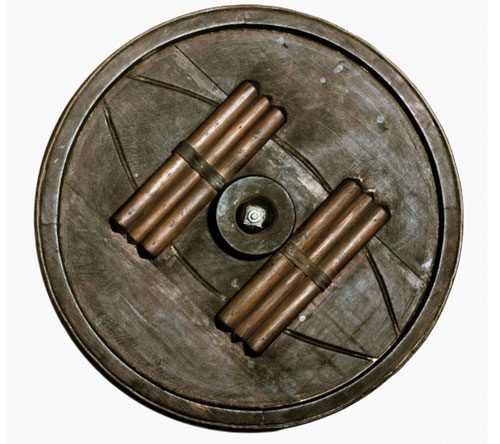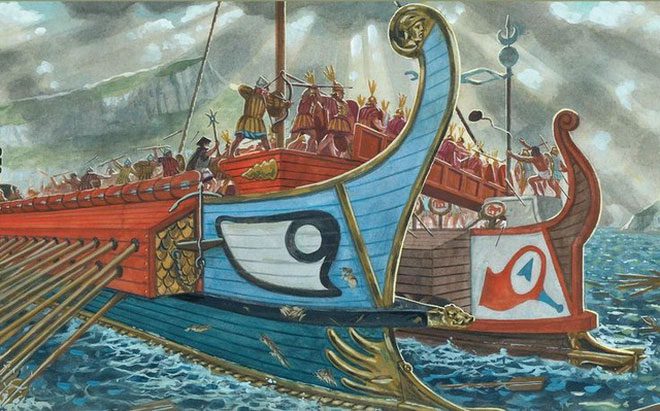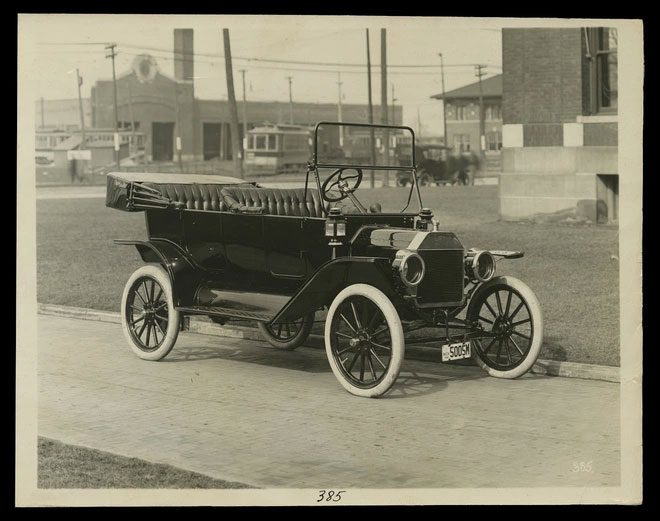The wheel industry has undergone a long process of development closely linked with human civilization.
The Formation and Development of the Wheel
The History of Wheel Development

An early wheel made from a solid piece of wood.
The wheel was invented in the 4th century BC in the region of Lower Mesopotamia (modern-day Iraq), where the ancient Sumerians attached rotating axles to a solid wooden “disk,” creating a roller.
However, there are also records suggesting that the Elamites were the true inventors of the wheel, as their sculptures depict the wheel as a “disk” made of stone or wood.
To transport large objects over long distances, humans needed as many “disks” as possible. Continuous use led to improvements, making the use of wooden logs increasingly efficient.
With the development of bronze and iron, people could carve and shape wood to make wheels rounder, thinner, and easier to roll. They also began using a horizontal beam underneath to prevent the wheel from slipping off.
People started to use two wheels accompanied by two horizontal beams, one placed at the front and one at the rear, forming a four-wheeled vehicle.

Images of wheels through the ages.
This innovation led to significant advancements in two main areas. First, transportation, as wheels began to be used on carts and chariots.
More importantly, it contributed to the mechanization of agriculture and related crafts, such as the application of centrifugal force to create windmills.
It wasn’t until 2000 BC that these “disks” began to be hollowed out to create lighter wheels.
Subsequently, spokes were invented, allowing wheels to use less material while maintaining functionality.

A wheel from Ur in the Mesopotamia region, 4th century BC, consisting of a wooden disk rotating on an axle. Photo: Aisa
Researchers believe that the ancient Egyptians were the pioneers of the spoked wheel equipped for horse-drawn vehicles around 2000 BC.
The next development was replacing spokes with iron. This design was found in Celtic chariots from 1000 BC. The spoked wheel retained its original form until 1802 when G.F. Bauer first introduced wire spokes.
Later, solid rubber began to be used for tires to reduce shock, which was then improved into inflatable tires thanks to John Dunlop’s work in 1888.
There Are No Wheels in Nature

A dung beetle pushing a round dung ball is the closest natural image resembling a wheel.
Throughout history, most human inventions have been partially inspired by the natural world. For example, the idea for the pitchfork and fork came from split sticks; airplanes from flying birds…
However, the wheel is considered a truly groundbreaking invention because it does not rely on any pre-existing structure in nature.
According to Michael LaBarbera, a biology professor and anatomist at the University of Chicago, only the flagellate and the dung beetle are organisms that use a rolling mechanism as a means of movement.
The Wheel Was Invented Quite Late

Boats were invented earlier than the wheel.
The motion model of the wheel is very simple, and even today, they remain extremely important to human life.
This leads us to believe that the wheel must have been invented very early, specifically when humans just began to learn to stand upright.
However, several complex inventions predated the wheel by thousands of years, such as the needle, woven fabric, rope, basket weaving, boats, and even flutes.
The First Wheel Was Not Used for Movement
Many pieces of evidence suggest that the wheel was first created to serve potters in Mesopotamia around 3500 BC.
It wasn’t until many centuries later that the wheel was applied for horse-drawn vehicles to transport goods.
The Wheel Was Almost Replaced by Camels

Camels once replaced the wheel as a mode of transportation in the Middle East.
Camels served as the standard mode of transportation in the Middle East and North Africa from the 2nd to the 6th century AD.
In the book “Camels and Wheels” by Richard Bulliet published in 1975, he argues that wheels and roads were once considered “outdated” and gradually disappeared after the fall of the Roman Empire.
Despite abandoning the wheel for transportation purposes, Middle Eastern societies continued to use wheels for tasks such as irrigation, milling, and pottery.
The First Wheel in North America Was Used as a Toy?
In the 1940s, archaeologists excavated toys with wheels in pre-Columbian sediment layers in Veracruz, Mexico.
Interestingly, according to history, Native Americans in North America did not use wheels for transportation until the arrival of European settlers.
Ford Cars Once Used Wooden Wheels

An early Ford Model T car using wooden wheels. (Photo: Ford).
The famous Model T “legendary” from Ford still used wooden and solid rubber wheels for a long time from the early years of the 20th century.
It wasn’t until 1926 and 1927 that spoked wheels with Dunlop inflatable tires “ousted” the “predecessor” wooden wheels to replace them on these cars.
While earlier models were either extremely expensive or unreliable, the Model T was considered the first “affordable” car to become popular, providing transportation for the majority of the American middle class and elevating wheel technology to a new level.




















































